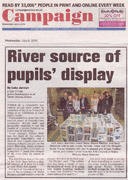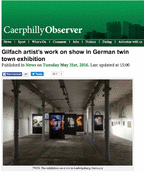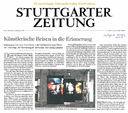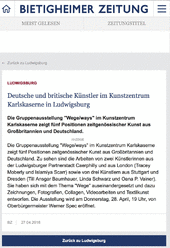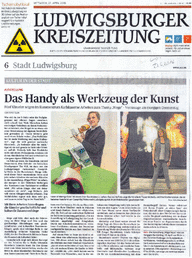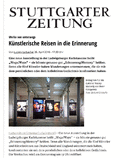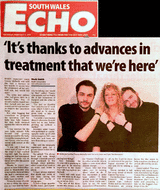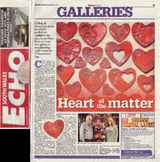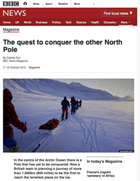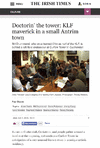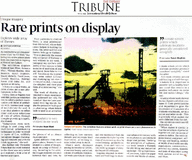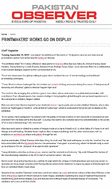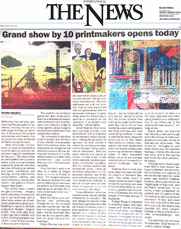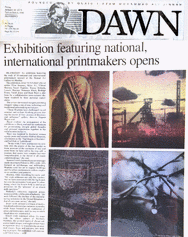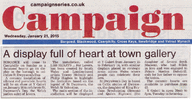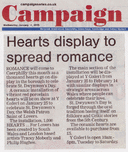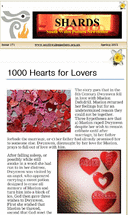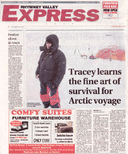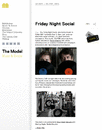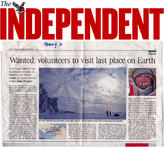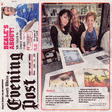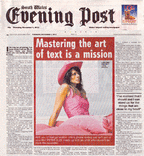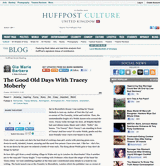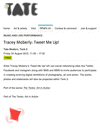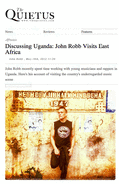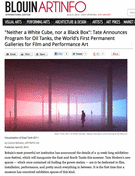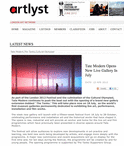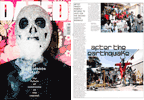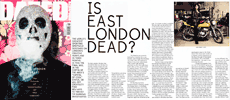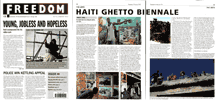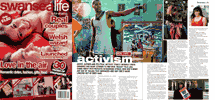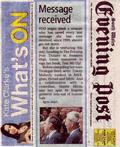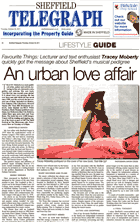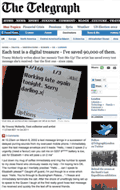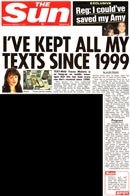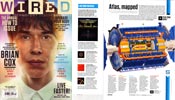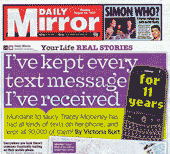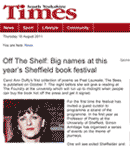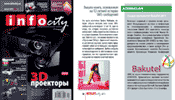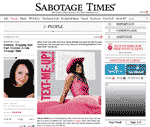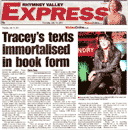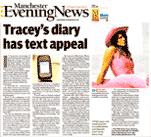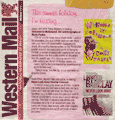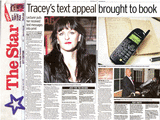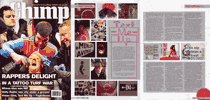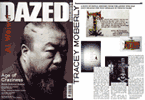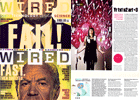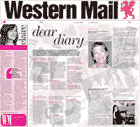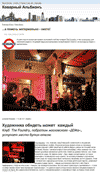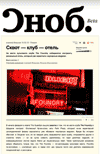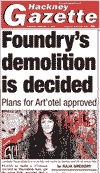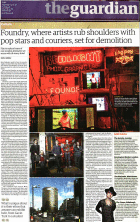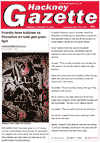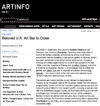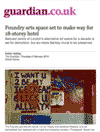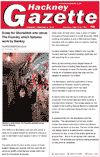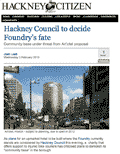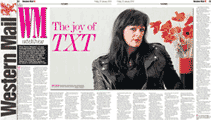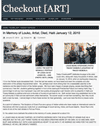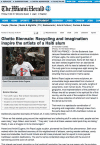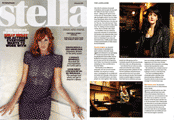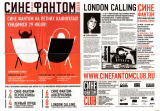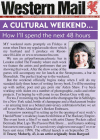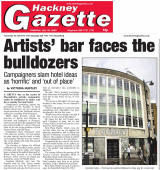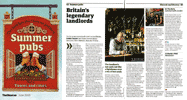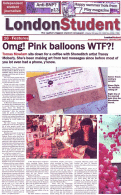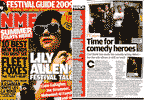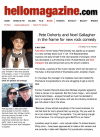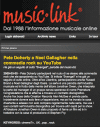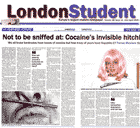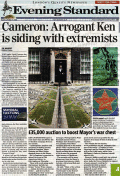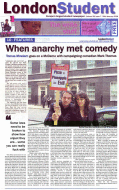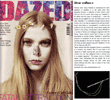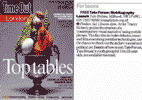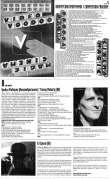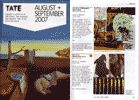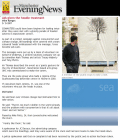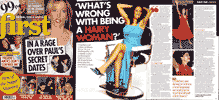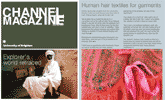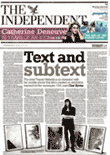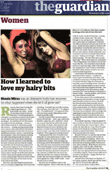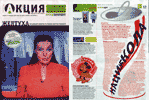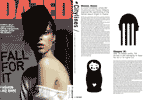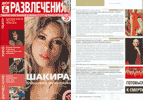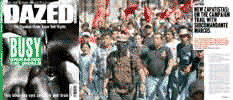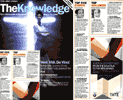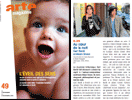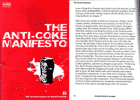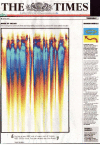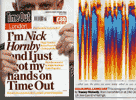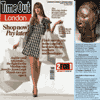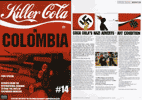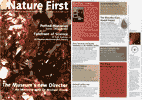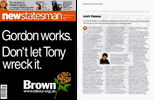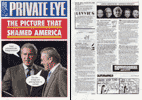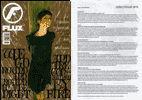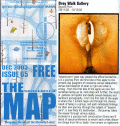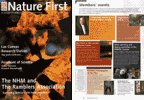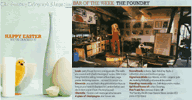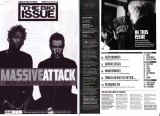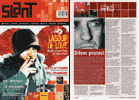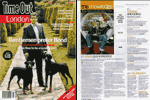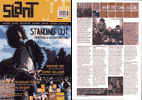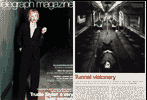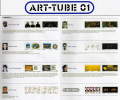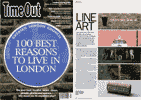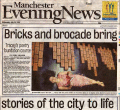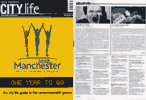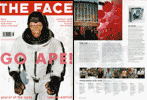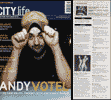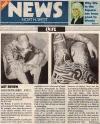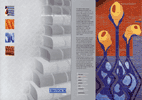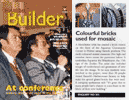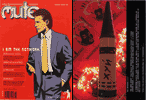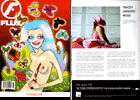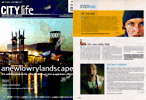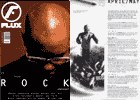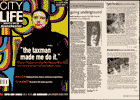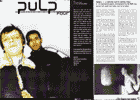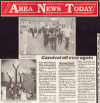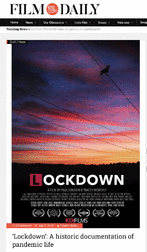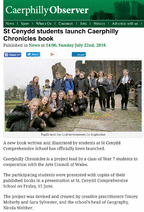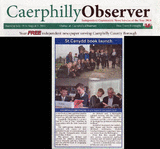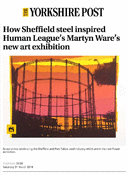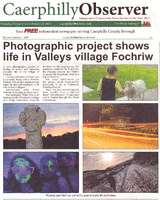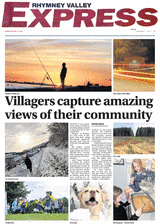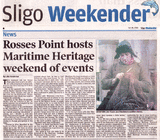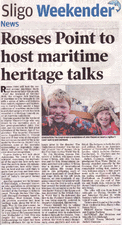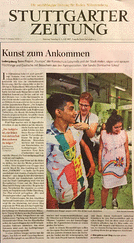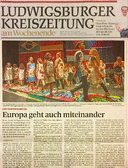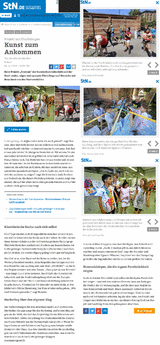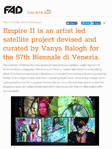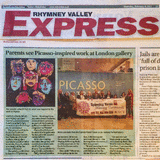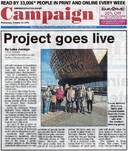[press]
[<<<] [>>>] click on image to enlarge

© tracey moberly 20160717.ft_article_1600.jpg
Financial Times
FT Weekend Arts
Tracey Moberly
'The camera sees it'
July 16, 2016
After setting fire to £1m on a Scottish island, what can a pop star and prankster do next?
Skegness, 4:15am, and Bill Drummond and I are careening through the empty streets in a van, past the shuttered shops, past the gathering seagulls and the mini golf, until we come to rest quietly on the edge of the sands. On the horizon, the morning is rising a brilliant pink, and Drummond strides in its direction, his sturdy frame powering towards the wind turbines. Near the water he stops, props his laptop on his leather jacket and begins, quite unceremoniously, to screen a film . . .
Drummond is a quite particular cultural figure. Now 63, he began his music career in 1977 as part of Big In Japan, and 10 years later founded the acid house band KLF who, with hits such as “3am Eternal”, “Doctorin’ the Tardis” and “Justified and Ancient”, were once the biggest-selling band in the world.
Then, in 1992, he and bandmate Jimmy Cauty staged a spectacular resignation from the music industry live at the Brit Awards, and deleted their entire back catalogue. Two years later, acting as arts group The K Foundation, he and Cauty burnt £1m — the remainder of their KLF earnings — on the Scottish island of Jura, then took a film of the burning on tour.
In the years since, Drummond has been prolific. There have been numerous books, the launch of an annual No Music Day, art projects. Although these works have perplexed some and frustrated others, they have proved intriguing to many. The documentary we are watching on Skegness beach is Imagine Waking Up Tomorrow And All Music Has Disappeared, Stefan Schwietert’s film about Drummond and his work, following in particular the path of his unorthodox global choir The17, which sings music without history, melody or lyric, and for which each recorded score may be played back only once, then deleted.
This is day one of Drummond’s mission to screen it at points along a line of latitude from the North Sea to the Atlantic; future stops will include a golf club, an Indian restaurant and a film festival, and end, as the film does, in the Aran Islands, looking out across the Atlantic. For this quest he has been joined by his frequent collaborator, the artist Tracey Moberly, and a few hours after the sunrise screening we reconvene in the hotel breakfast room, where Drummond sits barefoot eating the full English.
“When I first saw this film I was devastated,” he explains. “I wasn’t expecting to be exposed the way I was in the film. The second time, I was pleased that it existed, that something existed of this 10-year project. The third time I saw it I realised it had to be remade.”
Drummond at Arbor Low stone circle, Derbyshire©Tracey Moberly
Drummond at Arbor Low stone circle, Derbyshire
His plan now is to remake the documentary as a feature film, set in Madagascar. Moberly will direct. Over the coming days he plans to canvas opinions from his audiences as to how the remake ought to run. This morning a screening in a local school has been cancelled (nothing, I soon learn, ever quite goes to plan, but other plans are quickly spawned) and so we head off across cabbage fields to a roadside café on the A1 where Drummond and Schwietert filmed back in 2013. To his great disappointment, the café no longer stands, and in its stead is a mobile snack bar. We explain our reason for visiting to Martin and Danielle, who run the snack bar. “It does sound a bit weird though, what you’re doing,” says Danielle, one hand in her red apron, the other holding a cigarette. Drummond nods. “It is weird,” he concedes. “It is.”
This evening Drummond is screening the film at the home of Michael Miller, an academic who lives on the Soup Line, another Drummond project that entitles anyone living along the line between Belfast and Nottingham to ask him to visit and make soup. We arrive carrying pans and vegetables and a giant television screen, and Drummond sets to work chopping while the seven guests and one cat crowd into the living room and eat crisps. After soup, the blinds are drawn and the lights turned out and the film begins to run. Drummond lies down on the floor and very softly falls asleep.
That previous evening at Michael Miller’s house, he had claimed that music is all about voice, but as I quiz him about it the next day he contrarily turns tail. “Maybe it’s not. Maybe it’s all about rhythm,” he says. Drummond, I gather, does not relish being interviewed. Ask him a direct question and he will generally freeze, then turn the conversation around and interview the interviewer.
Only once does he appear to give a direct answer: when I ask about the apparent contradiction between his penchant for deleting his work and the fact that in Schwietert’s documentary we discover that he owns a storage lock-up and a shipping container, holding on to an archive of his life, right down to his school reports. “That is something I struggle with, believe me,” he says. “I pay for that every month.”
In his film, Schwietert attempts to sidestep Drummond’s reticence by getting a boy in a primary school class to ask him why he burnt £1m. Even after more than 20 years, it is still the thing people want to ask him, although he will never give an answer. Rather, as he does today, he will turn the question around: “Can you give me a good enough reason to burn a million pounds?”
This morning Drummond is at the other end of the scale, launching what he laughingly declares to be The Poundland Movement: a work of art that relies on materials bought in the central Nottingham branch of Poundland. We are rattling through the countryside when we see a sign pointing to an ancient stone circle named Arbor Low. We pull up, hike through fields of cows and sheep, and then Drummond sits in the middle of the circle, painting a Vimeo address and password on to small canvases. “Please don’t get paint on the stones,” Moberly calls.
There is no one to meet us at Buxton and High Peak Golf Club, nor at Portmeirion Pottery in Stoke-on-Trent where it is the annual holiday week, or at the Bombay restaurant, where the staff are observing Eid, and so we deliver the canvases and press on to Pwlhelli, where Peter, Sue and Dave host us in their garage-turned-cinema, and late into the night Drummond discusses the influence of the radio programme Late Junction, Kenneth Clarke’s 1969 TV series Civilisation and Bach’s The Well-Tempered Clavier. “The way he structured it is very mathematical, but you can’t stop the emotion coming through.”
I leave Drummond and Moberly the next day as they board a ferry from Holyhead to Dublin, continuing their journey west. A couple of nights later Drummond texts me from the Aran Islands: “Screening done on my iPhone on top of the cliffs . . . Although we were there at 10.04pm when officially the sun was setting we could see nothing but the grey of the Atlantic and the driving rain in our faces. It was brilliant.”
It reminds me of a scene in the film in which Drummond takes a giant canvas with the words “The17” painted on it and throws it into a puddle near an out-of-town shopping centre. “What does it mean if you throw it in there?” Schwietert asks, off-camera. “It looked like the perfect place to exhibit it,” Drummond replies brightly. “Why?” puzzles Schwietert. “Why?” booms Drummond. “Well, it looks fantastic.” “But no one will see it,” Schwietert points out. “I see it,” Drummond says. “The clouds see it.” He pauses, half-smiles. “The camera sees it.”
Captions:
A ‘screening’ of Stefan Schwietert’s documentary about Bill Drummond on Skegness beach, part of Drummond’s mission to show the film at points along a line of latitude from the North Sea to the Atlantic
Drummond at Arbor Low stone circle, Derbyshire
At Inishmore in Ireland
Photographs: Tracey Moberly
Copyright The Financial Times Limited 2016.
